 
|

|
|
February 2010 Chanderi Sarees - The drape of Royalty
It is a hard place to reach, one doesn't accidentally find oneself here, hence it took three busses, one train and three taxis to get this far. We started from Maheshwar at dawn, and trondled through the countryside on a "fast" train, which of course reached Lalitpur late. We knew we would be cutting it close, as we found out that the last bus to Chanderi is at 9pm. A rikshaw took us to the bus stand and by some odd chance the bus was still there, so we tried to board it in the frey of other passengers jostling for the last seats. After a long time of pushing and shoving, everyone was boarded and the engine was started and gunned for about ten deafening minutes. Something seemed to be amiss. As 9 turned to 9:30, they were still gunning and shutting down the motor. The road distance is only 40 kilometers but they told us it would take almost two hours to reach Chanderi. I started feeling insects crawling up my legs as we sat there in the dark waiting for them to fix the problem. At 10 we decided to get down and try to find a hotel in Lalitpur for the night. Lalitpur is one of those typically unremarkable mid size towns, with no comforts or interesting things to see. On this cold night after a day of travel it seemed like the entire male population was out on the street, most smelling of booze and looking for trouble. Lalitpur is actually in Uttar Pradesh, strangely enough smack dab in a thin sack of land that hangs down into the heart of Madhya Pradesh. Once you cross the border, the roads become awful, bumpy and dusty, the people harsh and staring - one expects to be held up at gunpoint here. We finally got one of the bus men, who were huddled teamlike around a huge battery in the dirt, to open the back so we could retrieve our luggage - there was no chance of getting the bus fare back. There are few hotels in Lalitpur, none that would be even remotely nice, but it was better than getting to Chanderi way after midnight and trying to find our way at such an hour. It was a full moon night and we were happy to be safely inside even this shabby, smeary, mosquito ridden room. Starving, we risked the food. In between all the sand I also found a huge piece of metal shaving in the jeera rice. I risked a few more bites and ducked under the blanket to fend off the mosquitoes. It's kind of a miracle that I slept at all. The realization of where we were as I woke up jolted me awake. The road was horrible all the way to the M.P. border - at which point, like a miracle it gets smooth and wide. Charming ChanderiBless the Madhya Pradesh Tourism Department, the hotel was so lovely - with a sweeping view of the countryside and the place practically to ourselves. The staff told us that we are in the same room that Kareena Kapoor stayed in recently. She and Aamir Khan visited Chanderi to help create public awareness about the harsh life of the weavers. So I am very happy to be sleeping in the same bed as this film star. The weavers were even invited to the Premiere in Mumbai. 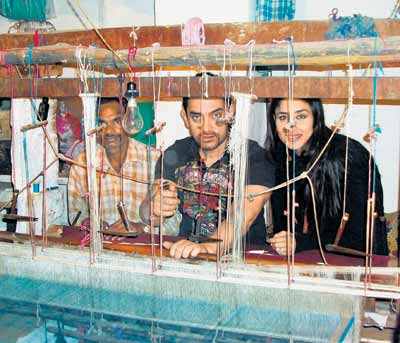 Supposedly the two actors "wove" a sari when they visited the weavers for an afternoon in the village of Pranpur outside of Chanderi. This sari is meant be auctioned off by an NGO aiding the weavers. It takes two people 8 days to weave one sari - a solo weaver will take 15 - so I doubt that they were able to weave more than a few crooked inches. They wore them to the Premiere of their recent movie "Three Idiots". Kareena said she was "upset that the weavers live in small huts with no electricity." Well even Kareena herself must have suffered the same plight - because half the day there is no electricity anywhere in Chanderi district, although a huge dam is just 2 km away. s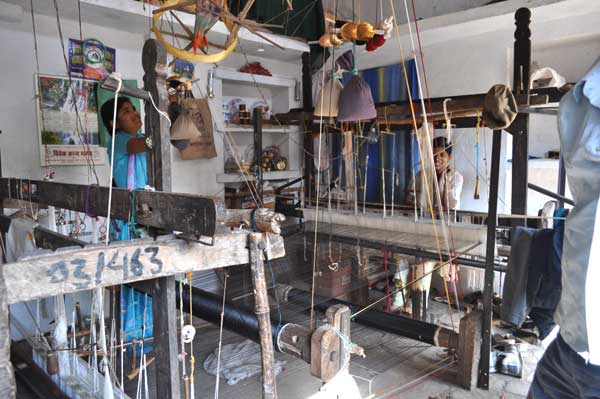
Other than the random Bollywood film star, they don't get many tourists in Chanderi - we got a lot of stares and comments. Wandering through the twisting narrow lanes between the white washed old houses we heard the familiar clacking of looms in many houses. A few open doors beckoned us to take a peek and one very friendly family invited me into their room. There were two overlapping looms and all the family's worldly goods on shelves and hooks. In the narrow strip beside the two looms sat a woman spinning bobbins. The kids were all looking on and being called by their elders to to small jobs around the loom, to fetch something or help fix a break. 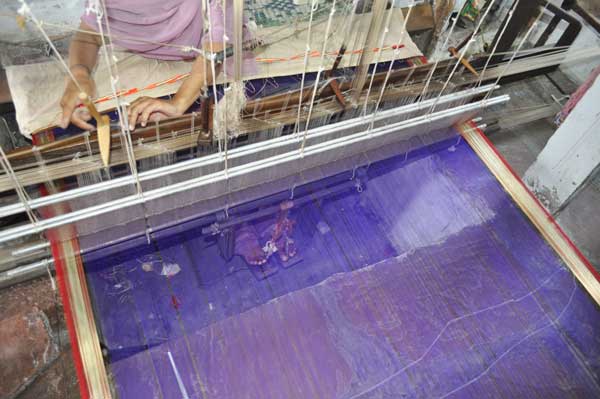
The rudimentary looms have very little patterning help from dobby or jacquard machines. Most of the butta are made by a separate set of string heddles suspended between the beater and the main heddles, which are string eyes suspended on metal rods, top and bottom. The fine thread count requires so many eyes so there are two sets of string heddles lashed together on double steel rods.
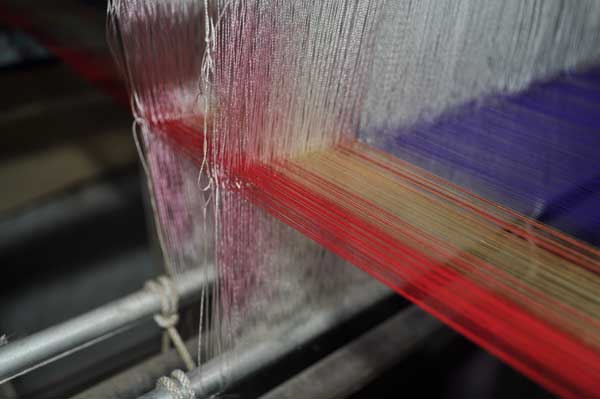
The fine fine silk warp is sleyed on two sets of string eyes lashed together. These heddles and the naka patterning heddles are constructed by special "karigar" or carftsmen who specialize in tying perfectly symmetrical and perfectly tensioned string heddles. The silk threads are so fine that there appears to be no bulk at all on the warp beams. The borders, generally with alot of zari are mercerized cotton and are separately tensioned. They hang over a set of pulleys and have bags of weights suspended on them to keep them tight. This set up allows the weavers to change border colors. 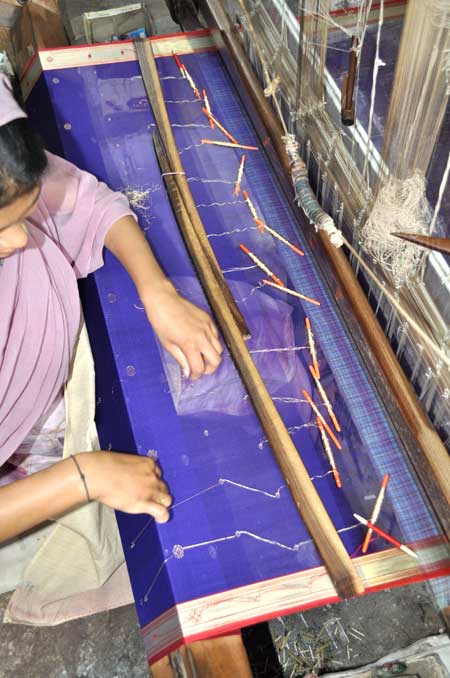 Plain cloth proceeds quite quickly, as the rubber band spring loaded fly shuttles make for fast weaving. They begin with the running blouse piece, usually in the same ground color. After two meters of plain ground the butta patterning starts - and this is what consumes most of the weavers time. The butta, usually done in zari thread are laid up with the help of supplementary heddles (naka). The butta patterns are made by lifting a sequence of tie up knots and squarely lifting the the heddles, which are completely made out of string, with four or five hammer like devices that hang from the castle of the loom. This set of supplementary heddles is secured on a separate frame to the sides of the loom. They are tied to these stationary side members to hold their tension across the width of the cloth, and underneath pin weights hold them down to keep the shed open. The string heddles are tied up at the center and inserting these pointed hammers into the strings holds them up square with each other. The butta threads are applied with a series of spools of zari spaced across the width. Spacing between the butta rows are counted in sheds. You can see the relief of speed weaving in the space between the pattern rows as the weaver counts the sheds in between. Here in this picture you see the weaving cutting the threads jumping between the butta. The wrong side of the sari always faces up so that they can keep track of the thread ends.
I asked the family matriarch a few questions about the work. I asked her if she works seven days a week - and she said "We have to work 8 days a week. When you work at home you are always working - there is always something to do." She sat in the narrow space between the two doors with a home made spinning wheel, winding up the bobbins. She said if I don't keep up with the bobbin winding how will they keep weaving. The older daughters were at it and sat two at the other loom, sharing the work across the work and doubling the production speed. Another daughter was called from the other room - also with a loom, to help the master measure the sari so far. They have a length of string for this purpose which he wrapped around the take up beam. He got her to mark on the border with permanent marker the 2 meter mark, at which point he will start working the butta on the design. So if you ever see black marks on the border you will know what they are for. 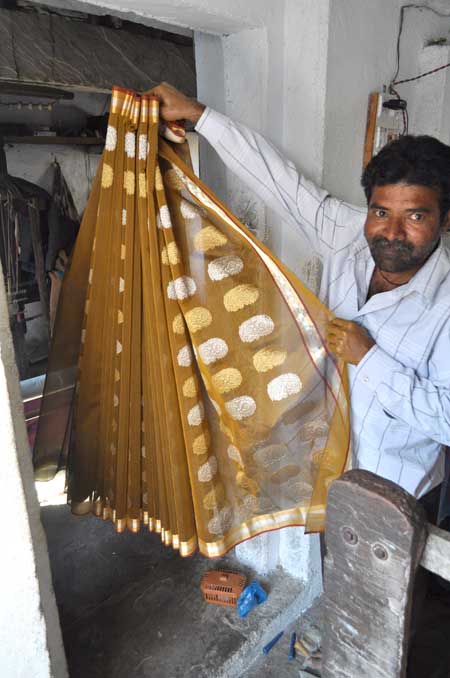
I asked the master if he likes his work. He looked oddly at me. I doubt anyone had asked him that before. "I just do it," he said in his paan garbled Hindi,"like my father and his father. It is our work." Then I asked him if he feels any pride when finishing a particularly beautiful piece and he said "yes definitely." Then I told him how much joy my customers feel when they look at these pieces, how much happiness he was providing to women. I don't think he'd ever heard that before, especially in funny foreigner Hindi from an odd woman who had just wandered into his home. He looked at me long after that comment and the Memsaheeb laughed and said yes you are right.
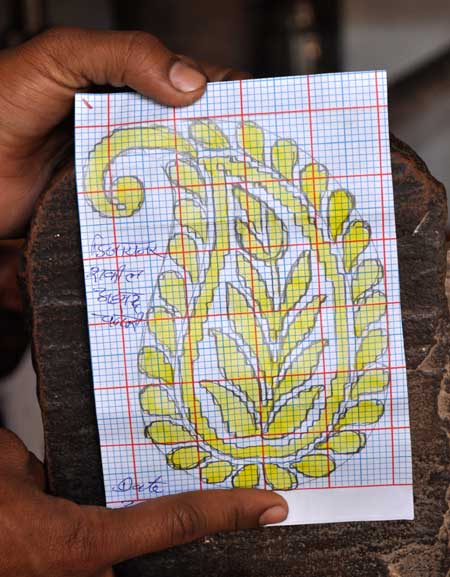 The more complicated patterns are drafted on a computer now and the weavers, lacking in high tech skills and equipment send out for this service. They showed me the pattern drawn on a grid. This is the pattern for the bigger ornaments on the pallu of the sari the weaver is holding in the photo above.
Despite the famous name of Chanderi, now even protected by Geographical Indication copyright, in the village of Chanderi itself you will not see one woman wearing a Chanderi sari, nor will you find them for sale in the village. All the shops are selling the usual poly chiffons and mill prints that are cheap and durable for daily wear or the fancy looking chamak dhamak for party wear. Chanderi is a sari originally produced for royalty and is for fancier clientele, usually buying from up market shops in the big metros. For now Chanderi is thriving with 5000 looms at work, it is the town's largest vocation - a success story holding its own in the shifting waters of the fashion market. Let's hope it can stay that way!
All images and text © Sarisafari |
|
Sitemap How to drape a sari Sari facts and fun Collection Overview |

|
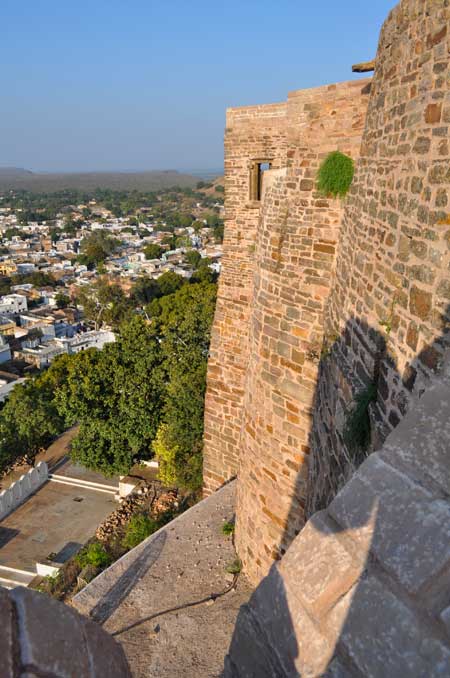 Chanderi is a small town in the high dry hills of North central Madhya Pradesh. It has been famous for its handlooms since the reign of the Scindia royal family. The picturesque whitewashed town is on a patch of high ground looking up at a 14th century fort. For good reasons there is a fort here, it was once the frontier of another kingdom and is a perfect place to watch potential invaders moving in on you.
Chanderi is a small town in the high dry hills of North central Madhya Pradesh. It has been famous for its handlooms since the reign of the Scindia royal family. The picturesque whitewashed town is on a patch of high ground looking up at a 14th century fort. For good reasons there is a fort here, it was once the frontier of another kingdom and is a perfect place to watch potential invaders moving in on you.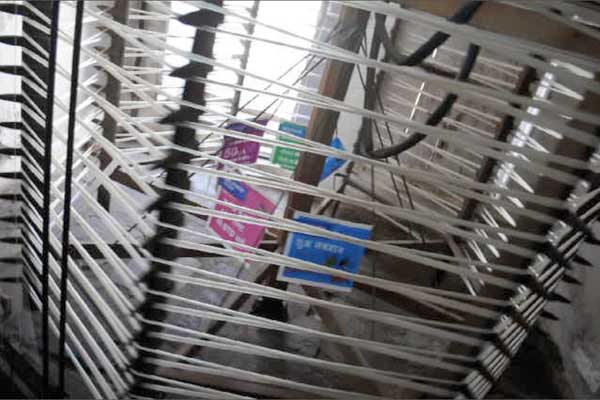 The very fine silk warp in 20 deniers only is mostly measured out by a separate warping family who provides the weavers with premeasured warps of a length of up to 18 sarees at once. The warping man explained that he has to be very careful when tying up the thread crosses on the long length of warp on the drum, losing it means losing the entire cost of the silk.
The very fine silk warp in 20 deniers only is mostly measured out by a separate warping family who provides the weavers with premeasured warps of a length of up to 18 sarees at once. The warping man explained that he has to be very careful when tying up the thread crosses on the long length of warp on the drum, losing it means losing the entire cost of the silk.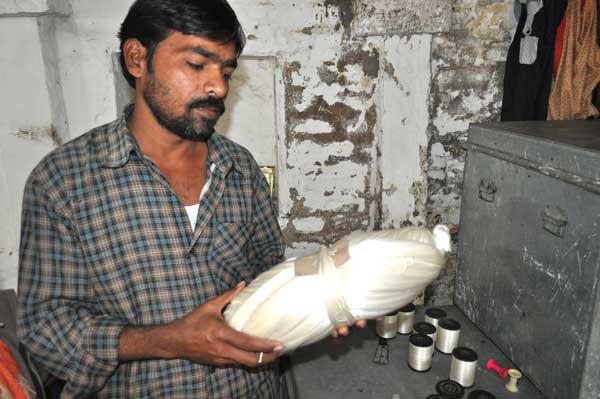 In this photo you see the small bulk of 18 sarees of warp.
In this photo you see the small bulk of 18 sarees of warp.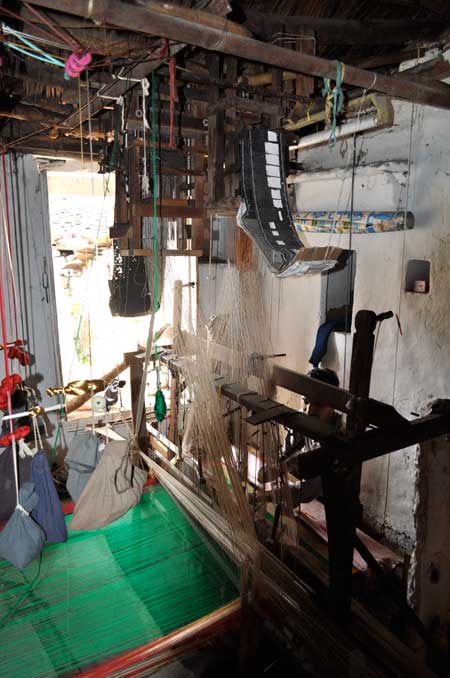 The rare jacquard machine in use by the even rarer independent weaver. He buys his own materials and sells his goods directly to a retailer. He bears the risk himself, unlike most of the weavers of Chanderi who work on a piece by piece basis. He is unusual in that he had the capital to buy stocks of fibers to weave and has been able to find a buyer for everything.
The rare jacquard machine in use by the even rarer independent weaver. He buys his own materials and sells his goods directly to a retailer. He bears the risk himself, unlike most of the weavers of Chanderi who work on a piece by piece basis. He is unusual in that he had the capital to buy stocks of fibers to weave and has been able to find a buyer for everything.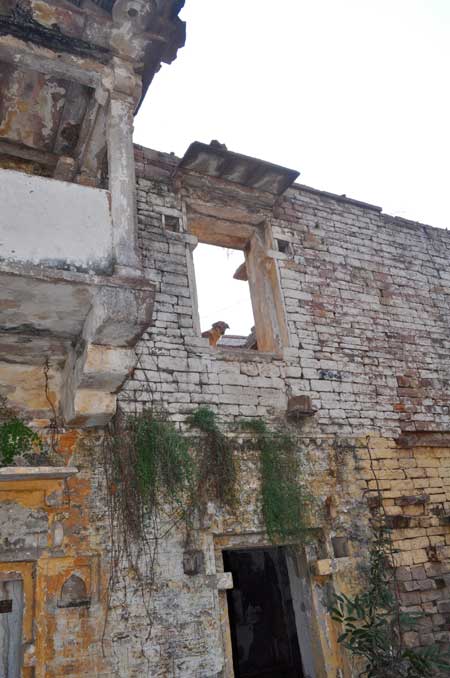 While watching the warping we stood in front of this 500 year old Haveli that has fallen into ruin. The weavers told us that it is the home of a once thriving weaving family. They explained that the pile of rubble in front of us used to be a dying house with four fire pits, and a broken room in the corner was once a luxurious shop receiving only the richest patrons. A whole family of looms once produced exquisite pieces for the Scindia Royal Family. As all the saints and sages keep telling us: Nothing lasts forever - the four brothers in the latest generation don't get along, have all moved to Bhopal with their own families and don't want to spend any of their money to restore the house. The dog peeking from the window is the only resident now.
While watching the warping we stood in front of this 500 year old Haveli that has fallen into ruin. The weavers told us that it is the home of a once thriving weaving family. They explained that the pile of rubble in front of us used to be a dying house with four fire pits, and a broken room in the corner was once a luxurious shop receiving only the richest patrons. A whole family of looms once produced exquisite pieces for the Scindia Royal Family. As all the saints and sages keep telling us: Nothing lasts forever - the four brothers in the latest generation don't get along, have all moved to Bhopal with their own families and don't want to spend any of their money to restore the house. The dog peeking from the window is the only resident now.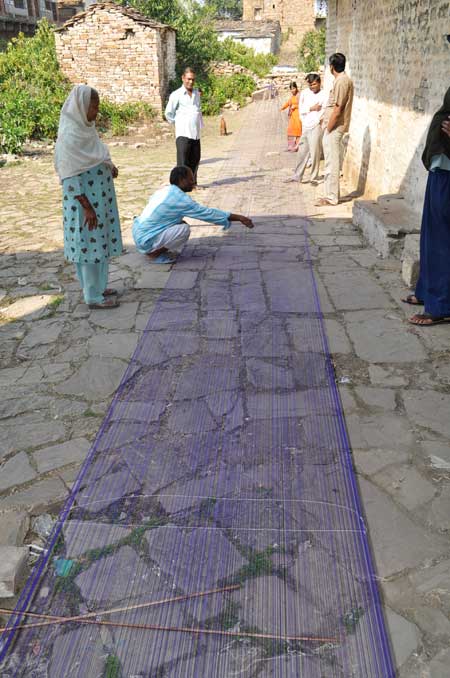 The whole family helps lay out the warp squarely with lease sticks and roll it carefully spaced onto the warp beam. It is very long and takes several passes, even on this long length of open ground. Spaced every two meters or so is a string holding the fibers in their shed, that the warp man carefully tied in while the warp was on the big warp drum. There are so many steps that have to be done just perfectly. The family carefuly untwists, combs and spreads the length of warp into its woven width on the beam. Two people hold the bamboo lease sticks and flick up and down to spread the fibers out square.
The whole family helps lay out the warp squarely with lease sticks and roll it carefully spaced onto the warp beam. It is very long and takes several passes, even on this long length of open ground. Spaced every two meters or so is a string holding the fibers in their shed, that the warp man carefully tied in while the warp was on the big warp drum. There are so many steps that have to be done just perfectly. The family carefuly untwists, combs and spreads the length of warp into its woven width on the beam. Two people hold the bamboo lease sticks and flick up and down to spread the fibers out square. As we were walking back to the wholesaler's shop we passed a very happy, very shanti man sitting in the sun. The weaver introduced him as his father and with the usual grace and flourish he explained that his father, and his father before had also been weaving there. I would have liked to join him there in the sun and hear some of his stories.
As we were walking back to the wholesaler's shop we passed a very happy, very shanti man sitting in the sun. The weaver introduced him as his father and with the usual grace and flourish he explained that his father, and his father before had also been weaving there. I would have liked to join him there in the sun and hear some of his stories.